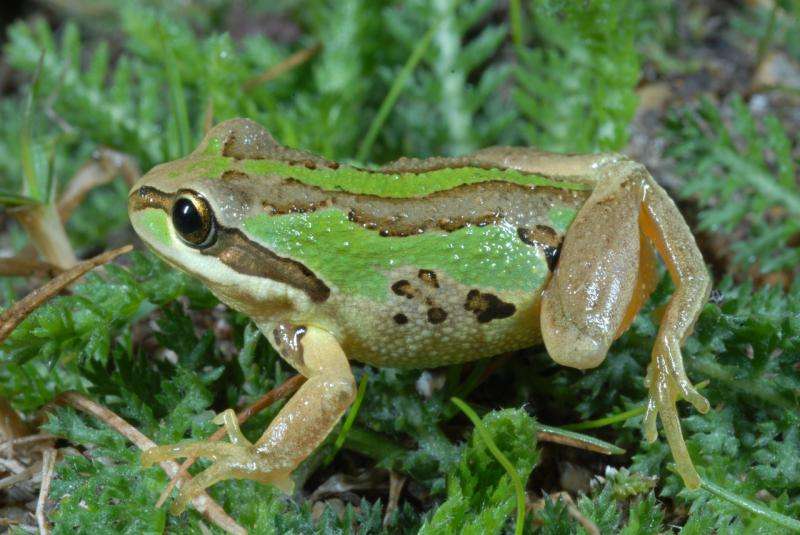Some frogs surviving deadly chytrid fungus infection

Australian scientists have found that some native frogs are winning their war against the world's most devastating frog-killer – the chytrid fungus – while others are losing it.
Studies by the ARC Centre of Excellence for Environmental Decisions (CEED) show the whistling tree frog is successfully beating the lethal fungus, as is the alpine tree frog. However the iconic yellow-and-black striped corroboree frog – a critically endangered Australian species – is fast losing the struggle.
The research is also revealing what causes frogs to live or die – providing scientists crucial clues in the fight to save the nation's remaining frogs, says Mr Ben Scheele, who recently completed his PhD with CEED at The Australian National University (ANU).
"Frogs catch the fungal infection through contact with infected water or direct contact with other infected frogs," says Mr Scheele. "It attacks the skin, making it difficult for the frogs to breathe, and this stops their heart eventually."
Research has suggested that the chytrid fungus has been spread by the African clawed frog, which carries it but is immune. For decades African frogs were exported worldwide following a 1934 discovery that they could be used for pregnancy tests in humans.
"Chytrid has since been found in over 500 amphibian species, and is now on all continents except Antarctica," Mr Scheele says. It has driven the decline of over 200 species, of which 113 are thought to be extinct. As Australian frogs face the same fate, we decided to investigate this killer, focusing on its long term effects."
Good news is that the whistling tree frog is recovering, since its population crashed in the 1980s, Mr Scheele says. Surveys show that year by year, the species is returning to habitats it used to occupy decades ago, and has even been found at 39 new sites.
"High quality habitat plays an important role. Many of the sites we looked at contained coarse woody debris which provided refuge for new colonisers. These ponds also had more plants and stable water levels which are needed to protect developing frog eggs and provide habitat for tadpoles," he explains.
Monitoring by the NSW Office of Environment and Heritage shows that numbers of endangered alpine tree frogs, despite going through a similar decline in recent decades, now appear stable. "Our studies reveal this is because chytrid is rare in their tadpoles and juvenile frogs, which enables the next generation to spread out in its woodland habitat free of the disease," says Mr Scheele.
"Although adult frogs later return to the wetlands to mate and contract the fungus, they are usually able to breed before they die."
On the other hand, the iconic northern corroboree frog, once abundant in Kosciuszko and Namadgi National Parks, is being pushed closer to extinction every day. While some frogs survived the fungus' attack in the 1980s, they are still infected through common eastern froglets that carry chytrid and share the corroboree frog's habitats.
Discover the latest in science, tech, and space with over 100,000 subscribers who rely on Phys.org for daily insights. Sign up for our free newsletter and get updates on breakthroughs, innovations, and research that matter—daily or weekly.
"For frogs that are losing the battle, we'll have to breed them in captivity or transfer them to environments that can help get rid of the fungus," says Mr Scheele. "These include ponds with shallow edge areas that heat up rapidly, as chytrid dies in warm temperatures. We can also deepen ponds and fill them with water, preventing them from drying during droughts and killing tadpoles."
It's crucial to maintain high quality habitats for frogs that are surviving or re-expanding their population, he adds. "Australians can also help by monitoring their local frogs – through programs such as FrogWatch – and help raise awareness on how to protect our amphibians.
"Our results show that given enough time, some amphibian species can recover from diseases, provided that high quality habitat is protected. So the simplest thing we can do for these species is to prevent further habitat loss."
More information: "Low impact of chytridiomycosis on frog recruitment enables persistence in refuges despite high adult mortality," Biological Conservation, Volume 182, February 2015, Pages 36-43, ISSN 0006-3207, dx.doi.org/10.1016/j.biocon.2014.11.032
"Decline and re-expansion of an amphibian with high prevalence of chytrid fungus," Biological Conservation, Volume 170, February 2014, Pages 86-91, ISSN 0006-3207, dx.doi.org/10.1016/j.biocon.2013.12.034
Journal information: Biological Conservation
Provided by Centre of Excellence for Environmental Decisions


















